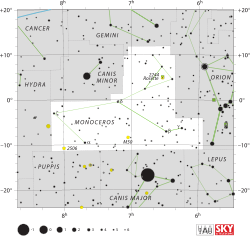Alpha Monocerotis

| |
| Observation data Epoch J2000.0 Equinox J2000.0 (ICRS) | |
|---|---|
| Constellation | Monoceros |
| Right ascension | 07h 41m 14.833s[1] |
| Declination | −09° 33′ 04.07″[1] |
| Apparent magnitude (V) | 3.94[2] |
| Characteristics | |
| Spectral type | K0 III[2] |
| B−V color index | 1.022[2] |
| Astrometry | |
| Radial velocity (Rv) | +10.50[2] km/s |
| Proper motion (μ) | RA: −74.61 ± 0.14[1] mas/yr Dec.: −19.59 ± 0.10[1] mas/yr |
| Parallax (π) | 22.07 ± 0.18[1] mas |
| Distance | 148 ± 1 ly (45.3 ± 0.4 pc) |
| Absolute magnitude (MV) | 0.71 ± 0.08[3] |
| Details | |
| Mass | 2.02 ± 0.29[3] M☉ |
| Radius | 10.1 ± 0.5[3] R☉ |
| Surface gravity (log g) | 2.71 ± 0.09[3] cgs |
| Temperature | 4,879[3] K |
| Metallicity [Fe/H] | −0.01[3] dex |
| Rotation | 326 days[4] |
| Rotational velocity (v sin i) | 1.9[4] km/s |
| Age | 1.18 ± 0.42[3] Gyr |
| Other designations | |
Alpha Monocerotis (α Mon, α Monocerotis) is the Bayer designation for the brightest star in the equatorial constellation of Monoceros.
It is a giant star with a stellar classification of K0 III[2] and is of apparent magnitude 3.93. It is approximately 148 light years from Earth.[1]
References
- 1 2 3 4 5 6 van Leeuwen, F. (2007). "Validation of the new Hipparcos reduction". Astronomy and Astrophysics. 474 (2): 653–664. arXiv:0708.1752
 . Bibcode:2007A&A...474..653V. doi:10.1051/0004-6361:20078357. Vizier catalog entry
. Bibcode:2007A&A...474..653V. doi:10.1051/0004-6361:20078357. Vizier catalog entry - 1 2 3 4 5 Hekker, S.; et al. (August 2006), "Precise radial velocities of giant stars. I. Stable stars", Astronomy and Astrophysics, 454 (3): 943–949, arXiv:astro-ph/0604502
 , Bibcode:2006A&A...454..943H, doi:10.1051/0004-6361:20064946.
, Bibcode:2006A&A...454..943H, doi:10.1051/0004-6361:20064946. - 1 2 3 4 5 6 7 da Silva, L.; et al. (November 2006), "Basic physical parameters of a selected sample of evolved stars", Astronomy and Astrophysics, 458 (2): 609–623, arXiv:astro-ph/0608160
 , Bibcode:2006A&A...458..609D, doi:10.1051/0004-6361:20065105.
, Bibcode:2006A&A...458..609D, doi:10.1051/0004-6361:20065105. - 1 2 Setiawan, J.; et al. (July 2004), "Precise radial velocity measurements of G and K giants. Multiple systems and variability trend along the Red Giant Branch", Astronomy and Astrophysics, 421: 241–254, Bibcode:2004A&A...421..241S, doi:10.1051/0004-6361:20041042-1.
External links
This article is issued from Wikipedia - version of the 11/20/2016. The text is available under the Creative Commons Attribution/Share Alike but additional terms may apply for the media files.